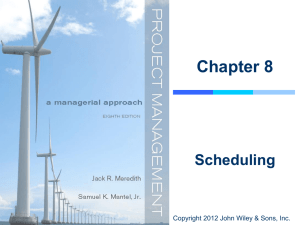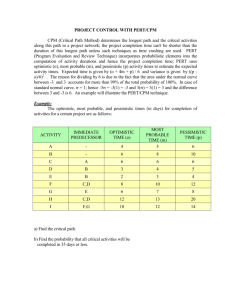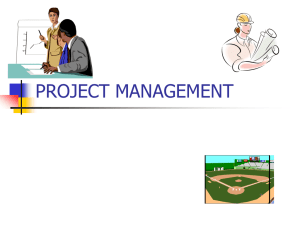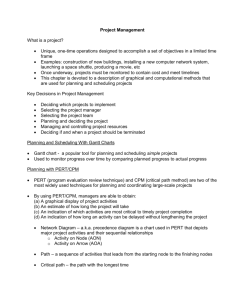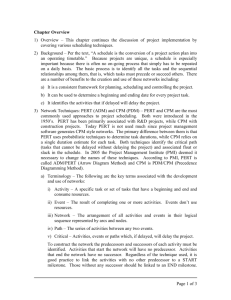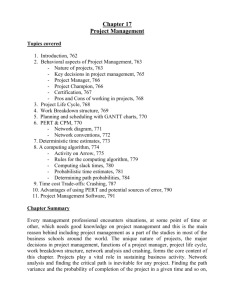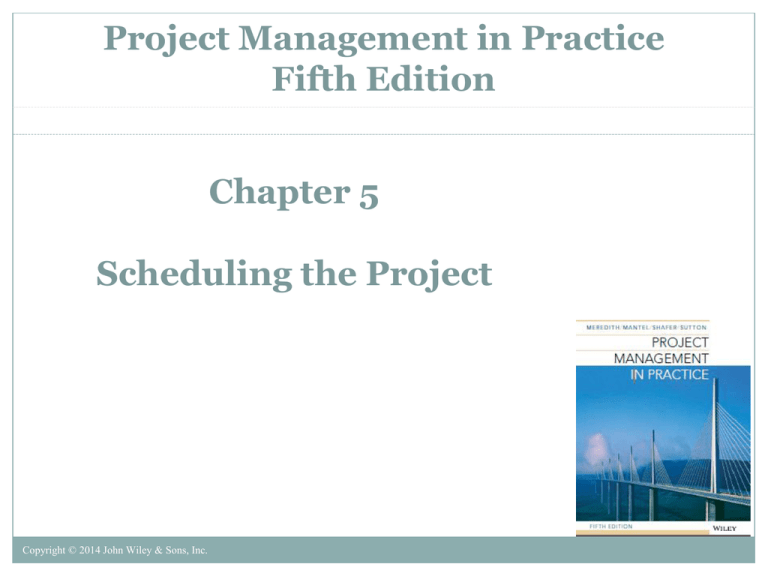
Project Management in Practice
Fifth Edition
Chapter 5
Scheduling the Project
Copyright © 2014 John Wiley & Sons, Inc.
Introduction
• Project schedule is the project plan in an
altered format
• It is a convenient form for monitoring and
controlling project activities
• Can be prepared in several formats
– Gantt charts
– PERT network
– CPM network
5-2
PERT and CPM Networks
• PERT and CPM developed independently in
1950’s
• Program Evaluation and Review Technique
(PERT)
– U.S. Navy, Booz-Allen Hamilton, and Lockheed
Aircraft
– Probabilistic activity durations
• Critical Path Method (CPM)
– Dupont De Nemours Inc.
– Deterministic activity durations
5-3
The Language of PERT/CPM
• Activity
– A task or set of tasks
– Uses resources and time
• Event
– An identifiable state resulting from completion of one
or more activities
– Consumes no resources or time
– Predecessor activities must be completed
• Milestones
– Identifiable and noteworthy events that mark significant
progress
5-4
The Language of PERT/CPM
Continued
• Network
– A diagram of nodes (activities or events) and arrows (directional
arcs) that illustrate the technological relationships of activities
• Path
– A series of connected activities between two events
• Critical path
– The set of activities on a path that, if delayed, will delay the
completion date of the project
• Critical Time
– The time required to complete all activities on the critical path
5-5
Building the Network
•
There are two ways of displaying a project
network
1. Activities on arrows (AOA) network
•
•
The activities are shown as arrows and events as nodes
Generally more difficult to draw but depicts the technical
relationships of the activities well
2. Activities on nodes (AON) network
•
•
•
Each task is shown as a node and the technological
relationship is shown by the arrows
AON network usually associated with CPM
AOA network usually associated with PERT
5-6
Sample AON Network
Table 5-1
Figure 5-3
5-7
Sample AOA Network
Table 5-1
Figure 5-6 (a)
5-8
Which to Use?
• Mostly AON used throughout this textbook
• AON used by most of the popular software
• AON networks are easier to draw by hand
– Large (20+ activities) AOA networks are
difficult to draw
• Software to draw AOA networks is
expensive
5-9
Finding the Critical Path and Critical
Time
•
•
•
•
•
•
•
ES: Earliest start time
EF: Earliest finish time
LS: Latest start time
LF: Latest finish time
Displayed on node as shown
ES + completion = EF
LS + completion = LF
Figure 5-9
5-10
A Sample Problem for Finding the
Critical Path and Critical Time
Table 5-2
5-11
The Complete Network
Table 5-2 and Figure 5-8
5-12
The Critical Path and Completion
Time for Sample Project
Figure 5-10
5-13
Notes on Sample Project
• All activities, and thus all paths, must be
completed to finish the project
• The shortest time for completion of the network is
equal to the longest path through the network
– In this case a-e-h-j
• If any activity on this path
is even slightly delayed,
the project will be delayed
5-14
Calculating Activity Slack
•
•
•
•
•
•
•
ES: Earliest start time
EF: Earliest finish time
LS: Latest start time
LF: Latest finish time
Slack = LS – ES
Slack = LF – EF
Either method of calculating slack gives the same
results
5-15
Managerial Implications
• The primary attention of the project
manager must be to activities on the critical
path
• If anything delays one of these activities,
the project will be late
• Projects are easier to manage when there is
project slack
5-16
Doing It the Easy Way—Microsoft
Project (MSP)
• Data is entered using a tab entry table
– Shown on next slide
• MSP automatically numbers each activity
• MSP has numerous options for viewing the
data
• MSP automatically draws an AON network
– Shown on later slide
5-17
A Microsoft Project Version of Data
in Table 5-2
Table 5-3
5-18
A Microsoft Project Version of the
PERT/CPM Network from Table 5-3
Figure 5-11
5-19
Calculating Probabilistic Activity
Times
• Figure below shows distribution of all possible
durations for some task
• Estimate a is such that the actual duration of the
task will be a or lower less than 1 percent of the
time
• Estimate b is such that the actual finish time will
be b or greater less than 1 percent of the time
• Estimate m is the most likely time
Figure 5-13
5-20
Activity Expected Time and
Variance
( a 4m b)
TE
6
(b a )
Var
6
2
2
5-21
95 Percent Level
• Task will be a or lower 5 percent of the
time
• Task will be b or greater 5 percent of the
time
(b a )
3.3
5-22
90 Percent Level
• Task will be a or lower 10 percent of the
time
• Task will be b or greater 10 percent of the
time
(b a )
2.6
5-23
The Probabilistic Network
• Expected time (TE) for each activity is calculated
• Variance (σ2) for each activity is calculated
• TE for each activity is used to find the critical path
and critical time for the network
– Slack is calculated in the usual fashion
• The variance (σ2) of a path is the sum of the
activity variances for that path
– Standard deviation (σ) is the square of the variance
5-24
The Probabilistic Network, an
Example
Table 5-4
5-25
Is it Really the Critical path
• Given uncertainty, cannot be sure that any specific
path is the critical path
• “Critical” path may take less than expected while
another path takes longer
• Only after the fact do we know which path was
actually critical
• Managerial implication is the project manager
must carefully manage all paths that have a
reasonable probability of becoming critical
5-26
Once More the Easy Way
• Microsoft Project can easily handle the
probabilistic network
– However, it does not perform some of the calculations
– These can be done in Excel
• Microsoft Project calculates using a calendar
rather than days
• Uses a real-world calendar including weekends
and holidays
5-27
The Probability of Completing the
Project on Time
• Can the project be completed in X days?
• Can be answered with the information
available concerning the level of uncertainty
for the various project activities
– Assumes activities are statistically independent
• To complete a project by a specified time
requires that all the paths in the network be
completed by the specified time
5-28
The Probability of Completing the
Project on Time Continued
• Determining the probability that a project is
completed by a specified time requires calculating
the probability that all paths are finished by the
specified time
• We then calculate the probability that the entire
project is completed within the specified time by
multiplying these probabilities together
– This requires the assumption that the paths are
statistically independent
5-29
Calculating Path Probability
• D = desired project completion Z D
2
time
– 50 in this example
• μ = the sum of the TE activities
on the path being investigated
50 47
1.78 0.25 0.00 4.00
1.10
– 47 in this example
• σ2u = the variance of the path
being considered
• A Z of 1.10 yields a probability
of 0.8643 or 86 percent
Table 5-4
5-30
The Statistical Distribution of the
Completion Times for Example
Figure 5-18
5-31
Selecting Risk and Finding D
5-32
Simulation
• Simulation is a different approach to
managing risk
• Builds on the probabilistic functions already
discussed
• Helps to understand the consequences of
uncertainty
• Provides insight into the range and
distribution of project completion times
5-33
Crystal Ball Chart for Project
Completion Time
Figure 5-19
5-34
Traditional Statistics vs. Simulation
• Both approaches assume that task times are
statistically independent
• Both approaches assume the paths are independent
– A simulation can circumvent the assumption of
statistical independence by including the activity or
path dependencies as part of the model
• Simulation requires less computational effort
5-35
The Gantt Chart
• Henry Gantt developed the Gantt chart
around 1917
• It displays project activities as bars
measured against a horizontal time scale
• Most popular way of exhibiting sets of
related activities in the form of schedules
5-36
The Chart
• Gantt charts are easy to draw
• Problems arise when several tasks begin at the
same time and have the same duration
– Can make it hard to find critical path
– Only a problem on hand-drawn charts
• Software shows critical path using some visual
method
• Even with software, technical dependencies are
harder to see on a Gantt chart
5-37
A Gantt Chart of a Sample Project
Figure 5-21
5-38
A Gantt Chart Showing Critical
Path, Path Connections, Other Data
Figure 5-22
5-39
Extensions to PET/CPM
• Application of fuzzy set theory to aid in
estimating activity durations
• Extensions to precedence diagramming
• Goldratt’s Critical Chain
5-40
Precedence Diagramming
• Finish to start (F to S)
– Finish of Activity A to start of Activity B
• Start to start (S to S)
– Start of Activity A to start of Activity B
• Finish to finish (F to F)
– Finish of Activity A to finish of Activity B
• Start to finish (S to F)
– Start of Activity A to finish of Activity B
5-41
Precedence Diagramming
Conventions
Figure 5-25
5-42
Copyright
Copyright © 2014 John Wiley & Sons, Inc.
All rights reserved. Reproduction or translation of this work
beyond that permitted in Section 117 of the 1976 United
States Copyright Act without express permission of the
copyright owner is unlawful. Request for further information
should be addressed to the Permissions Department, John
Wiley & Sons, Inc. The purchaser may make back-up copies
for his/her own use only and not for distribution or resale.
The Publisher assumes no responsibility for errors, omissions,
or damages, caused by the use of these programs or from the
use of the information herein.
5-43

